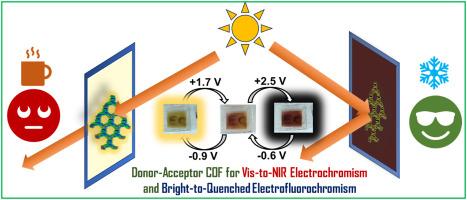原位生长的含苯并三噻吩的共价有机框架膜用于双响应可见至近红外电致变色和亮至猝灭电致荧光智能窗口
IF 6.3
2区 材料科学
Q2 ENERGY & FUELS
引用次数: 0
摘要
共价有机框架(COFs)由于其卓越的机械坚固性、高表面积、可调孔隙率和固有结晶度而引起了人们的极大兴趣,使其成为电化学器件的理想选择。准确地说,具有π共轭和供体-受体(D-A)性质的低带隙氧化还原活性COFs适合于在可见光到近红外(NIR)范围内的电致变色。本文通过一锅缩合反应合成了共轭D-A型COF bth - tz -COF,并在氧化铟锡(ITO)镀膜玻璃上原位生长薄膜,克服了非原位形成COF薄膜的典型局限性。粉末x射线衍射(PXRD)表明bth - tz - cof结晶度高,在2θ = 4.32°处有一个尖峰,brunauer - emmet - teller (BET)分析证实其比表面积为819 m2/g,具有微孔性质。制备的固态电致变色器件(ECD)表现出可逆的多色EC响应,在+1.7 V和+2.5 V下,由于亚胺和bth部分的氧化,从黄色到橙色再到红棕色。ECD显示出在700 nm和1000 nm的高显色效率,分别为768.4 cm2/C和491.7 cm2/C,并且在可见光和近红外范围内快速切换(~ 5 s)。此外,bth - tz - cof薄膜有效地阻挡了67%的太阳辐射,并且功耗低,适合智能窗户应用。该装置还表现出可逆的电荧光变色(EFC),其中薄膜的亮黄色荧光在+2.5 V时猝灭,在−0.9 V时恢复。该研究展示了用于下一代节能EC和EFC智能窗户的坚固、双功能COF薄膜的开发。本文章由计算机程序翻译,如有差异,请以英文原文为准。

In-situ grown benzotrithiophene-containing covalent organic framework film for dual-responsive visible-to-near infrared electrochromic and bright-to-quenched electrofluorochromic smart windows
Covalent organic frameworks (COFs) have attracted massive interest because of their exceptional mechanical robustness, high surface area, tunable porosity, and intrinsic crystallinity, making them ideal for electrochemical devices. Precisely, low bandgap redox active COFs with π-conjugation and a donor-acceptor (D-A) nature are suitable for electrochromism across the visible to near-infrared (NIR) range. Herein, a conjugated D-A type COF, BTTh-Tz-COF, was synthesized via a one-pot condensation reaction and grown in-situ thin film on indium tin oxide (ITO)-coated glass, overcoming the typical limitations of ex-situ COF film formation. Powder X-ray diffraction (PXRD) exposed high crystallinity of BTTh-Tz-COF with a sharp peak at 2θ = 4.32°, and Brunauer–Emmett–Teller (BET) analysis confirmed a surface area of 819 m2/g with a microporous nature. The fabricated solid-state electrochromic device (ECD) exhibited reversible multicolor EC response, covering yellow to orange to reddish-brown under +1.7 V and +2.5 V, attributed to oxidation of imine and BTTh moieties. The ECD revealed high coloration efficiencies of 768.4 cm2/C at 700 nm and 491.7 cm2/C at 1000 nm, and fast switching (∼5 s) in both visible and NIR ranges. Furthermore, the BTTh-Tz-COF film efficiently blocked 67 % of solar irradiation and disclosed low power consumption, making it appropriate for smart window applications. The device also showed reversible electrofluorochromism (EFC), where bright yellow fluorescence of the film was quenched at +2.5 V and recovered at −0.9 V. This study demonstrates the development of a robust, dual-functional COF film for next-generation energy-efficient EC and EFC smart windows.
求助全文
通过发布文献求助,成功后即可免费获取论文全文。
去求助
来源期刊

Solar Energy Materials and Solar Cells
工程技术-材料科学:综合
CiteScore
12.60
自引率
11.60%
发文量
513
审稿时长
47 days
期刊介绍:
Solar Energy Materials & Solar Cells is intended as a vehicle for the dissemination of research results on materials science and technology related to photovoltaic, photothermal and photoelectrochemical solar energy conversion. Materials science is taken in the broadest possible sense and encompasses physics, chemistry, optics, materials fabrication and analysis for all types of materials.
 求助内容:
求助内容: 应助结果提醒方式:
应助结果提醒方式:


